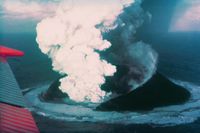Portal:Iceland/Selected article/1
Surtsey (Icelandic: "Surtur's island") is a volcanic island off the southern coast of Iceland. At 63°18′N 20°37′W / 63.30°N 20.62°W it is also the southernmost point of Iceland. It was formed in a volcanic eruption which began 130 metres below sea level, and reached the surface on 14 November 1963. The eruption may have started a few days earlier and lasted until 5 June 1967, when the island reached its maximum size of 2.7 km². Since then, wind and wave erosion has seen the island steadily diminish in size: as of 2005[update] it is only 1.4 km² in size.
The new island was named after the fire giant Surtur from Norse mythology, and was intensively studied by volcanologists during its creation and, since the end of the eruption, has been of great interest to botanists and biologists as life has gradually colonised the originally barren island. The undersea vents that produced Surtsey are part of the Vestmannaeyjar (Westmann Isles) submarine volcanic system, part of the fissure of the sea floor called the Mid-Atlantic Ridge. Vestmannaeyjar also produced the famous eruption of Eldfell on the island of Heimaey in 1973. The eruption that created Surtsey also created a few other small islands along this volcanic chain, such as Jólnir and other unnamed peaks. Most of these eroded away fairly quickly.

